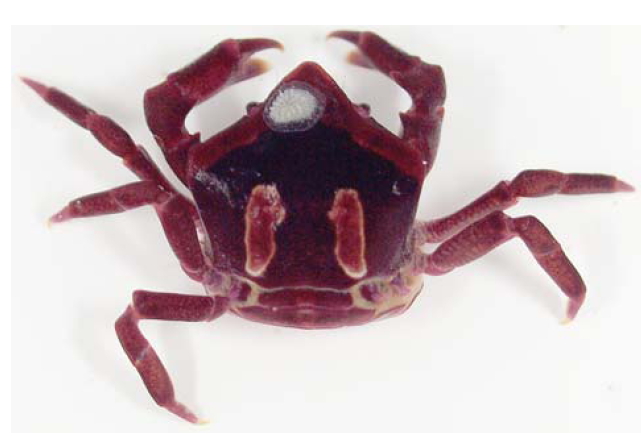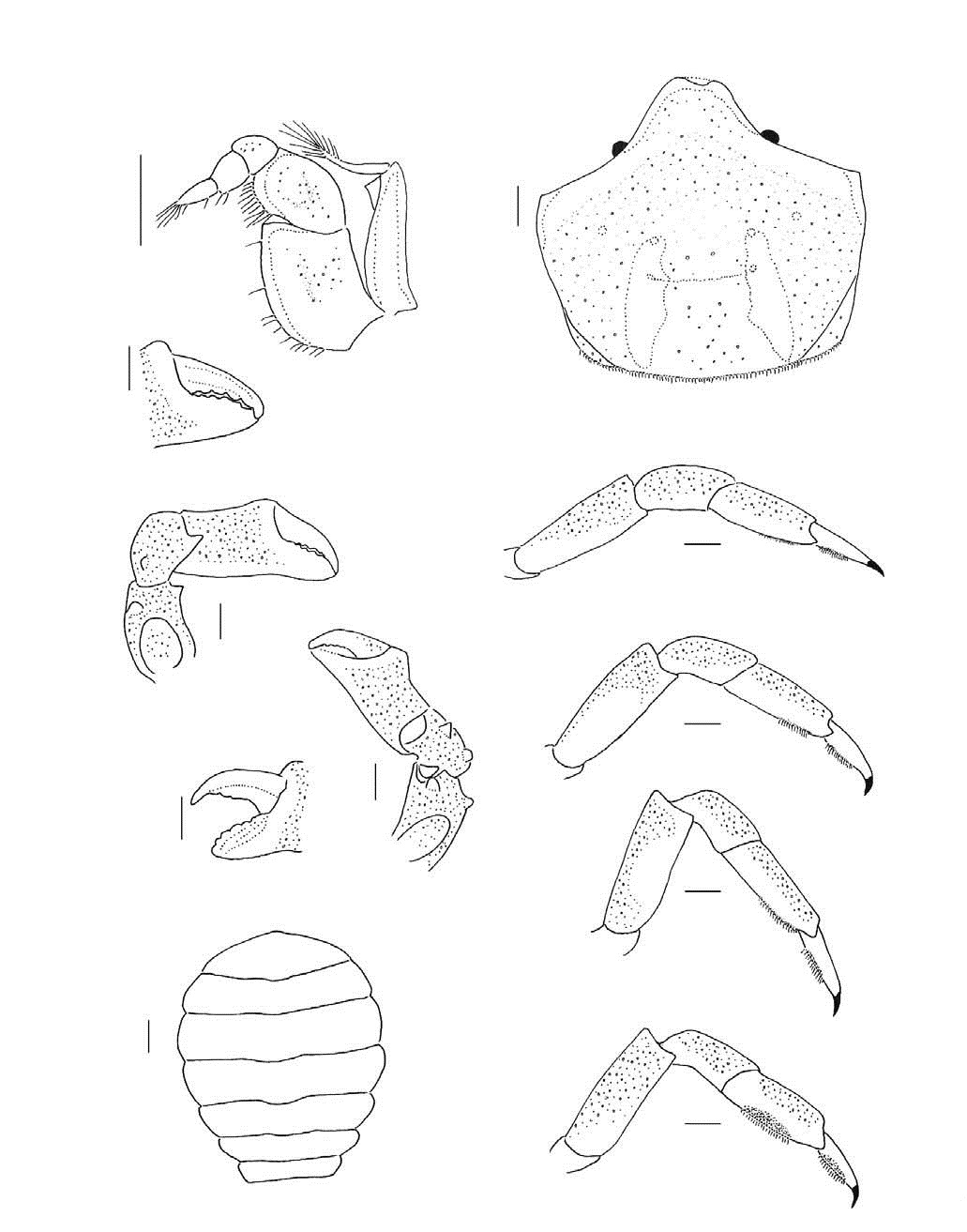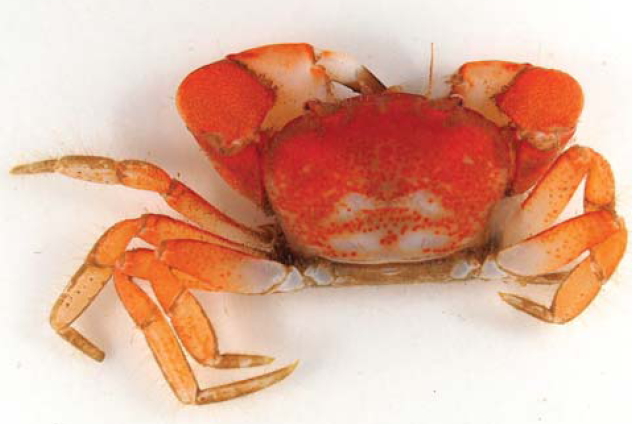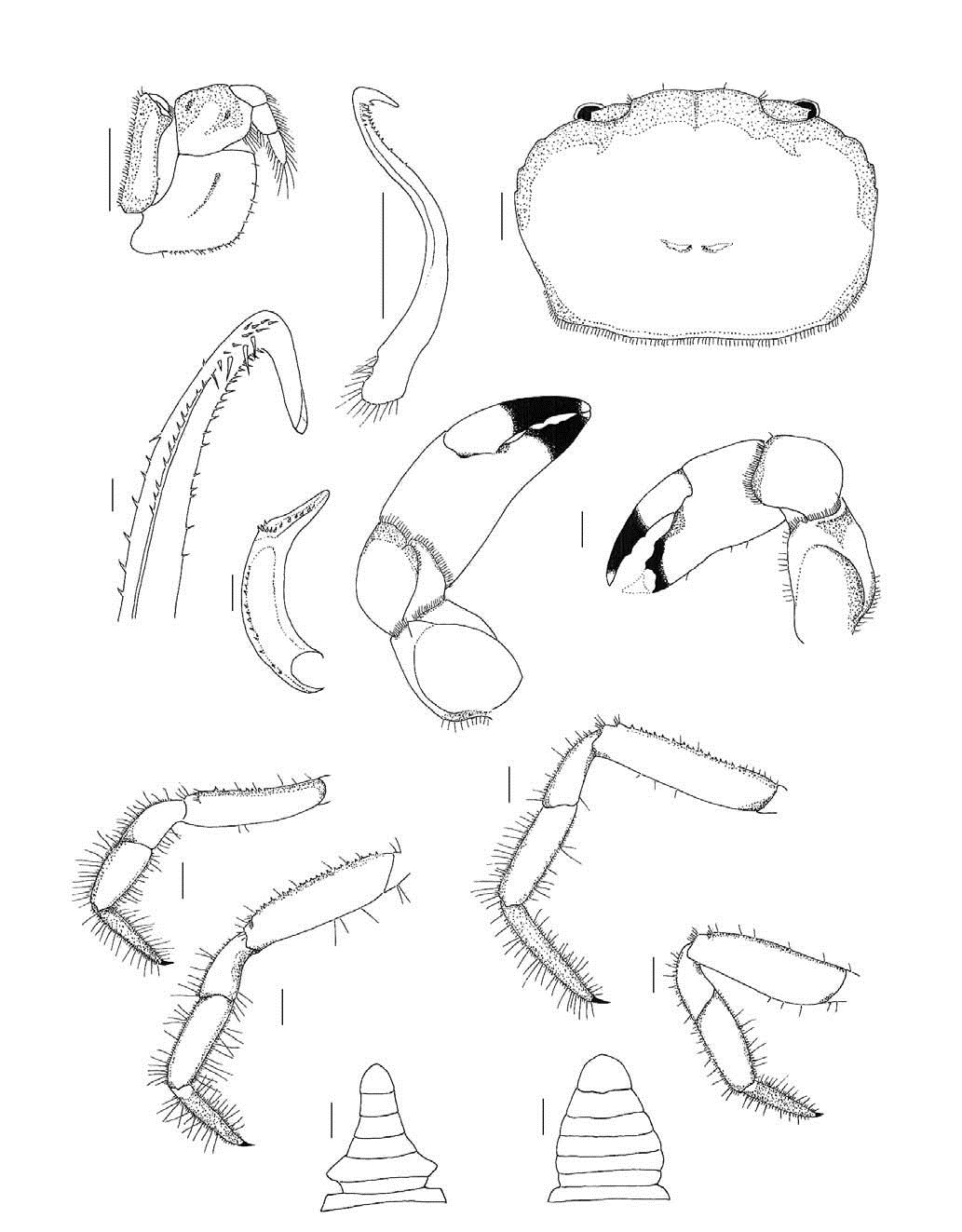



At present, five subfamilies are recognized in the family Pilumnidae (see Ng et al., 2008): Calmaniinae, Eumedoninae,Pilumninae, Rhizopinae, and Xenophthalmodinae. Eumedoninae, with three species, and Pilumninae, with nine species,have so far been reported from Korean waters (Kim and Kim,1997; Lee et al., 2008; Lee and Ko, 2009). During a survey on decapod fauna from Jejudo Island, two eumedoninid crabs associated with sea urchins and two rhizopinid crabs were collected. The eumedonid crabs were identified as
Drawings were made with the aid of camera lucida. The abbreviation “cl” refers to carapace length from the tip of frontal margin to the posterior dorsal margin of the carapace. All specimens were preserved in 95% ethanol. The brachyuran classification follows that of Ng et al. (2008). All specimens are deposited at the corresponding author’s collection of Silla University, Busan.
Order Decapoda Latreille, 1802
Family Pilumnidae Samouelle, 1819
Subfamily Eumedoninae Dana, 1852
1*Genus
2*
Materials examined. 1♀ (cl 7.8 mm), Hyeongjeseom Island,12 Aug 2010, Lee KH, SCUBA at 12 m depth; 1♀ (cl 7.5 mm), Seongsanpo, 17 Oct 2010, Lee SH, SCUBA at 15 m depth.
Description. Carapace (Figs. 1, 2A) pentagonal, punctuate, about 1.1 times broader than long; rostrum short, broad, triangular, length approximately 0.35 width of its base; regions poorly defined on surface; antero- and posterolateral margins clearly demarcated by small tooth; posterior margin slightly concave medially.
Third maxilliped (Fig. 2B) quadrate; ischium rectangular,median oblique sulcus shallow; merus slightly rounded; exopod almost reaching antero-external edge of ischium.
Chelipeds (Fig. 2C, D) punctuate, subequal; merus with blunt inner and outer teeth; carpus with blunt outer proximal tooth and sharp inner distal tooth; propodus short; cutting margins of each fingers with 3-4 blunt teeth.
Ambulatory legs (Fig. 2E-H) punctuate, subcylindrical; anterior margins of meri terminating in small angles; carpi without setae; posterior margins of propodi and dactyli with short setae on legs 1-3, with dense short setae on leg 4.
Female abdomen (Fig. 2I) broad, segments 4, 5 broadest. Telson broad, length 1/3 width of its base.
Color in life. Entire animal generally purple red or pale purple red; carapace with longitudinal whitish purple red stripe on each epibranchial region.
Habitat. These crabs were found on the external surfaces of sea urchins.
Remarks. Chia et al. (1999) defined the genus
Distribution. Japan and now Korea.
1*Subfamily Rhizopinae Stimpson, 1858
2*Genus Zehntneriana Ng and Takeda, 2010
3*
Materials examined. 1♂ (cl 5.5 mm), 1♀ (cl 5.3 mm), Munseom Island, 13 Aug 2010, Lee KH, SCUBA at 15 m depth.
Description. Carapace (Figs. 3, 4A) transversely ovate, about 1.4 times broader than long; regions not defined except for median longitudinal shallow furrow and gastrocardiac transverse depression; surface almost naked, only frontal, supraorbital, and anterolateral regions covered with dense short setae;anterolateral margin separated into 3 tooth like crests, last small granular tooth; posterior margin wide, slightly concave medially.
Third maxilliped (Fig. 4B) broad; ischium rectangular, median oblique sulcus distinct; merus with 2 prominent depressions.
Chelipeds (Fig. 4C) robust, subequal; merus with blunt tooth on upper margin, dense brush like setae on distal margin; inner blunt angle of carpus prominent, dense brush like setae on distal inner margin; propodus smooth, stout; fingers blunted, its distal half black, cutting margins sharply toothed.
Ambulatory legs (Fig. 4D-G) generally long, stout, leg 3 longest; meri minutely serrated on anterior margins; carpi
fringed with setae on anterior margins; propodi fringed with setae on both margins; dactyli as long as propodi, covered with dense short setae.
Male abdomen (Fig. 4K) relatively narrow; segment 1 broadest;segment 6 about 1.8 times broader than long. Telson semicircular; length subequal to width of its base. Abdomen of female (Fig. 4L) relatively broad; segment 1 broadest. Telson relatively narrow, length 0.7 times of width of its base.
Gonopod 1 (Fig. 4H, I) long, slender, curved, with stout setae on distal one-thirds; tip bent about 60˚, bluntly pointed.
Gonopod 2 (Fig. 4I) short, stout, curved, with row of small spines on surface.
Color in life. Carapace generally bright red except on cardiac and intestinal regions. Chelipeds bright red on upper surfaces. Ambulatory legs pale red.
Habitat. These crabs were found under the stones.
Remarks. Our specimens agree well with the original description of Takeda and Miyake (1969). The genus
Distribution. Japan and now Jejudo Island in Korea.



